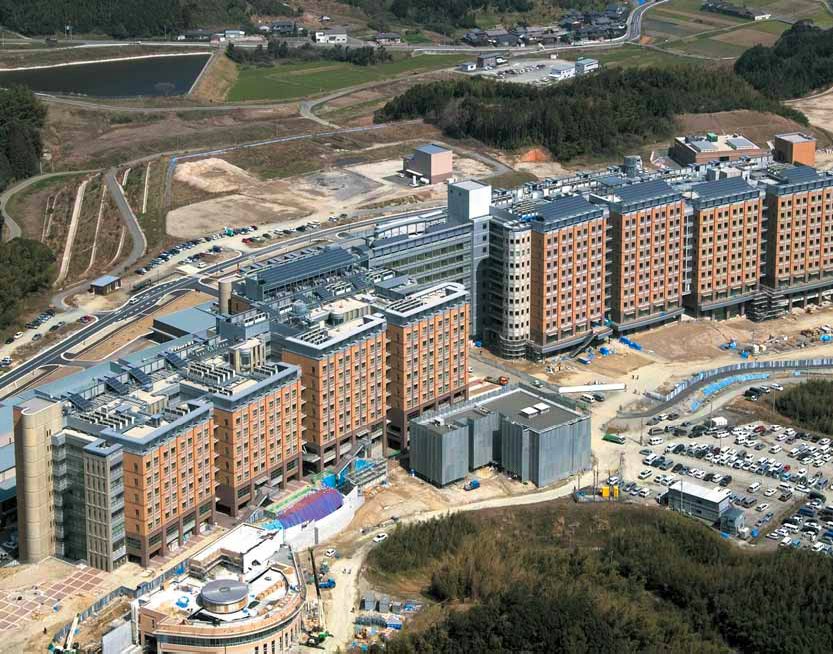
ITO New Campus
Creating a New Integrated Campus: the Background
In order to respond to global scale changes in society, Kyushu University is forming a world-class, education and research center, and is making progress with new innovations in order to further develop the center. It will serve as the core of the new campus.
Kyushu University decided to form the new campus to solve the following problems:
1.The University's separate campuses have been an obstacle to smooth co-operation and links between general undergraduate-education courses and specialty/graduate courses, and to collaborative research.
2.Deterioration and a lack of available space have made it difficult to upgrade and diversify educational and research facilities. A shortage of green spaces has also contributed to a lack of balance in the campus.
3.Because the Hakozaki Campus is located on the approach to Fukuoka Airport, noise by aircraft has formed a significant obstacle to education and research. There has also been concern about the possible recurrence of accidents.
4.Redevelopment and maintenance of facilities has been difficult because of restrictions placed on intensively used, multi-story buildings in the Hakozaki area, due to various factors such as limitations on the height of buildings under aviation laws and regulations.
Relocation Schedule
Fifteen years have passed since October 1991, when the University Council decided to move the University to the Motooka/Kuwabara district of Nishi Ward in Fukuoka City. Since this decision, many difficult problems have been dealt with due consideration on environmental and historical aspects by utilizing the University's knowledge and good sense. Construction of the new campus is moving forward as planned, with exception of Sector II. Development of the education and research facilities for the faculty of engineering, and other facilities, is proceeding as planned. In addition, Gakuen-dori Avenue is under constraction and a new JR train station was installed on September 2005. Half of the faculty of engineering moved to the new campus in October 2005, and the other half will move by the end of fiscal year 2006.
According to the relocation schedule, the faculty of engineering will move during the first stage. This will be completed within FY 2006. From the first to second stages, site preparation will be conducted in Sector II and reimbursement of land acquisition cost to the Fukuoka city government will be completed at an early stage. The construction of buildings for science, humanities, general undergraduate education, agriculture faculties and general unbergraduate education will start from FY 2011, at the end of the second stage. Relocation to the new campus will be complete by the end of FY 2019.
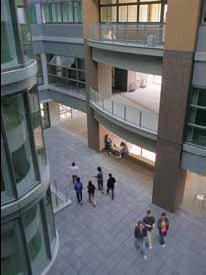 |
 |
| Š ( ) Brackets indicate possible finance-related changes in relocation years Šy@z Brackets indicate round figures of people to be relocated ŠPlanned year may change due to future financial situation. |
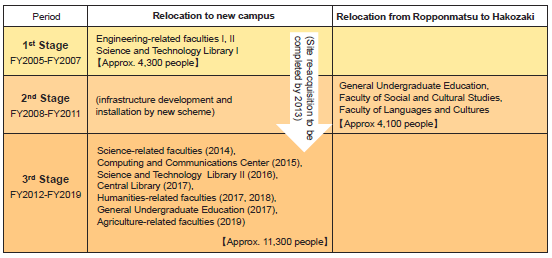 |
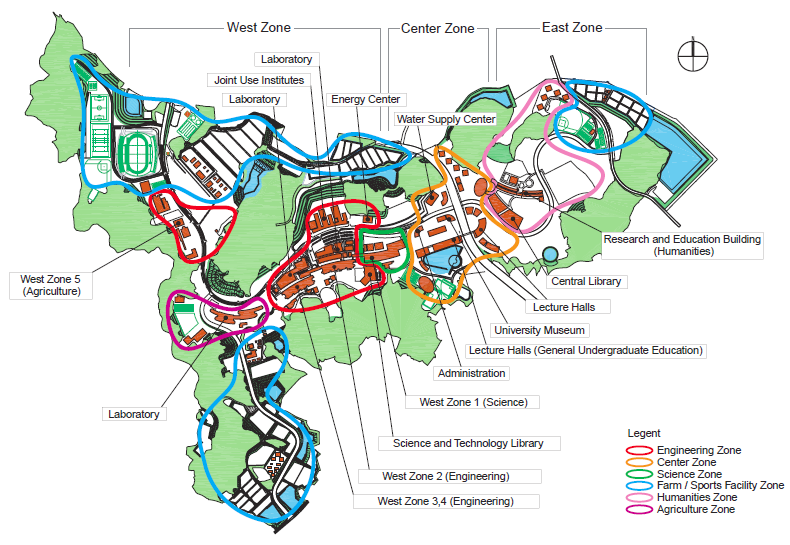 |
Construction of the new campus provides a good opportunity to launch new education and research projects. These include: "Research towards a hydrogen fuel consuming society," "Campus - wide IC card project," and "Protection measures for underground water in the new campus"This 21st century research satisfies expectations for a completely new campus and related facilities.
The New Campus Plan
Framework and guidelines for consistent long-term campus development have been collected in the "Kyushu University New Campus Master Plan 2001."
In the Master Plan, nine targets are laid out, pointing to the creation of an excellent research and educational environment: "Coexistence of a symbolic space that creates its own traditions and a space which can flexibly change and regenerate," "Symbiosis of the eternal history and natural surroundings of the Itoshima region," and "Development of a safe and comfortable campus environment." Directives were laid out with regard to the establishment of an objective for the entire campus and a concept for the formation of space, land use, traffic conditions, infrastructure, internal spaces for research and education facilities, and phased construction and development. A block plan for Engineering, Science and Center zones has been created based on the Master Plan. Architectural design and building construction are proceeding according to this plan.
The new Kyushu University is being created so as to have a special character of its own. In the "Public Space Design Manual," general design policies have been compiled for public spaces to be developed throughout the campus. The components of these design policies (land-scape, colors schemes, signage, trees and plants, lighting and so on) will create an attractive campus with a distinct personality and a sense of unity.
Hydrogen Campus Project
Various joint projects between industry and academia are being planned and carried out at the Ito Campus. One of these is the Hydrogen Campus Project.
The goal of this project is to conduct multifaceted research on hydrogen, with Kyushu University and Fukuoka Prefecture as the key players, supported by the Ministry of Education, Culture, Sports, Science and Technology, the Ministry of Economy, Trade and Industry, and the world of industry. More than three hundred people, including students, technicians, assistants, assistant professors, and professors, are working together - conducting research and development on the use of hydrogen energy, training experts, and carrying out demonstration projects.
In addition, the Hydrogen Technology Research Center has been established. This is the only center in the world for research into integrated technologies for the safe use of hydrogen, and it is expected to become the projectfs leading research base.
Campus-wide IC Card Project
In order to improve services for the student body, as well as to enhance the level of efficiency of university operations by digitizing the whole campus, a plan to embed IC chips into student and staff identification cards is being developed. This will become the basis for conducting studies on the practical application of the advanced information system that was inaugurated with the opening of the new campus in the fall of 2005. This plan will advance upgrades to services and improve efficiency of business within the university, in accordance with the incorporation of national universities. As an area of comprehensive research and education activity, the IC card plan will also promote discussions from the vantage points of the humanities and social sciences with regard to the advanced technology of the new campus, and will generate proposals for the future direction of the university as an information society. This project will take the initiative on such new social issues as protection of personal information, and identity authentication in a networked society.
Through the use of IC cards on campus, services and efficiency can be improved in a wide-range of applications that target students and staff. These include school services, use of equipment and facilities including libraries and computers, prevention of crime and safety management, and automobile registration management. It is hoped that the introduction of campus-wide IC cards for all faculties will encourage the new campus to develop as a truly integrated university that can address the issue of what society should be in the 21st century.
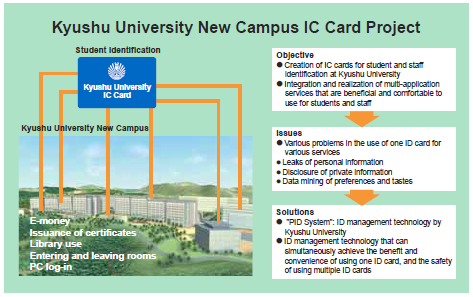 |
Conservation and Management of Groundwater in the new campus
In the past, the area where the new campus is being constructed was a valuable watershed for the Mizusaki, Obaru, and Sugiyama Rivers, on hilly and primarily forested terrain. This area is also a valuable source of underground water that is used in the surrounding region. Therewas anxiety that the construction of the new campus would ruin the circulatory balance of the groundwater and surface water, and that it might have an impact on groundwater use and the natural environment. In 2000, Kyushu University carried out an environmental impact assessment which suggested basic policies related to the protection of groundwater, and last July, a water circulation conservation plan was developed to present and clarify concrete counter-measures. Even in today's society, where environmental protection awareness is high, this is the first such approach taken in Japan.
Among their detailed contents, the measures include lessening reliance upon asphalt paving for roads (which obstructs the infiltration of rainwater), and a rule requiring water-permeable retaining catchments, drainpipes, and gutters to be constructed around buildings. Methods used to develop structures that allow for easier penetration of water include placing holes in drainpipes (picture @) and spreading gravel or loose stones at the bottom of catchments (picture A). Devices that permit water penetration into the ground over a period of time are also being developed, including spreading plastic blocks to make hollow cavities, and temporary storage of rainwater in surrounding areas under nearby parking lots and campus grounds where drainpipes pass under the soil.
While these measures will require additional costs over and beyond that of regular construction costs, Kyushu University believes that they are indispensable for cooperating with, living symbiotically with, and simultaneously developing with the surrounding area. These are basic good manners for anyone looking to develop this area.
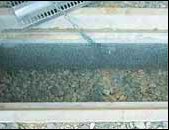 |
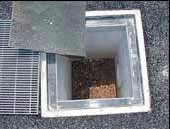 |
| picture @ | picture A |
Previous PageTop Next